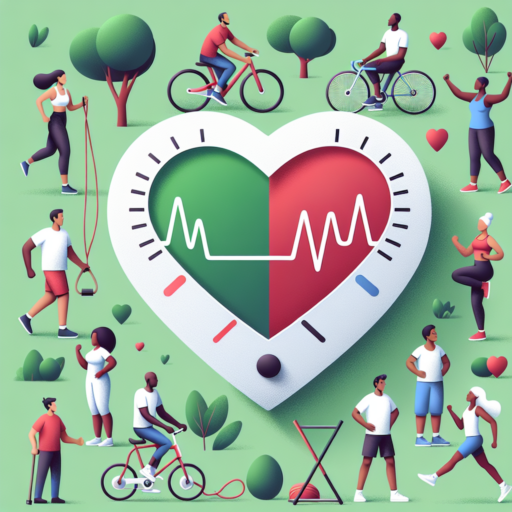Understanding HRV Range: What It Tells About Your Health
The concept of Heart Rate Variability (HRV) has gained prominence in the realm of wellness and fitness monitoring, offering insightful data about one’s cardiovascular and overall health. HRV refers to the variation in time intervals between consecutive heartbeats, a metric that reveals the adaptability of your heart to stress, rest, and recovery. Understanding your HRV range can provide critical insights into your body’s autonomic nervous system functionality, essentially how well your body handles stress and recuperates.
Key Indicators of HRV and Their Health Implications
HRV is more than just a number; it’s a window into your physiological resilience and stress levels. An optimal HRV range suggests a healthy balance between the sympathetic (‘fight or flight’) and parasympathetic (‘rest and digest’) branches of your autonomic nervous system. Conversely, consistently low HRV readings could signal overstress, poor sleep quality, or underlying health issues. By monitoring changes in your HRV, you can gauge the effectiveness of your fitness routines, stress management strategies, and relaxation techniques.
What Constitutes a Healthy HRV Range?
Identifying a «healthy» HRV range can be complex due to individual variances based on age, sex, fitness level, and genetic factors. Generally, a higher HRV indicates better cardiovascular fitness and stress resilience, while lower values may point to fatigue, stress, or potential health concerns. It’s imperative to monitor your HRV trend over time rather than fixating on single measurements to truly understand your health and wellbeing trajectory.
The Importance of Monitoring Your HRV Range for Overall Wellness
Heart Rate Variability (HRV) provides critical insights into our overall well-being, acting as a window into the autonomic nervous system. The importance of monitoring your HRV range cannot be overstated. It offers a unique, non-invasive way to understand how your body responds to stress, exercise, and relaxation. By keeping tabs on your HRV, you’re essentially listening to the internal dialogue between your heart and your brain, providing valuable information that can guide you towards healthier lifestyle choices.
One key aspect of HRV monitoring is its ability to predict stress levels. A higher HRV indicates a relaxed state where the body can effectively manage stress, while a lower HRV suggests a stressed system, struggling to adapt. Monitoring these changes empowers individuals to take proactive steps in managing stress, such as engaging in mindfulness practices or adjusting their workout routines. This level of self-awareness is crucial for maintaining overall wellness and mitigating the long-term effects of chronic stress.
Additionally, HRV is heavily tied to our physical fitness. Fluctuations in your HRV range can signal overtraining or under-recovery, urging a closer look at your exercise regimen and recovery practices. Fitness enthusiasts and athletes alike can benefit from this data to optimize their training schedules, balance exertion with rest, and prevent potential injuries. By valuing the role of HRV in wellness, we can make informed decisions that enhance our physical and mental health.
How to Accurately Measure Your HRV Range for Better Health Insights
Understanding your Heart Rate Variability (HRV) is key to gaining deeper health insights. This metric, which represents the variation in time between each heartbeat, is a powerful indicator of your autonomic nervous system’s flexibility and your overall well-being. To accurately measure your HRV range, embracing a multifaceted approach can significantly enhance the precision of your readings.
Choosing the Right Time and Consistency
One of the first steps to ensure accurate HRV measurement is consistency in your testing routine. It is particularly recommended to take your HRV readings at the same time every day, preferably in the morning upon waking. This minimizes the impact of external variables that could skew your results. Engaging in this practice daily establishes a reliable baseline, making it easier to notice any significant changes or trends.
Utilizing Reliable Tools and Apps
The technology you use to measure your HRV plays a pivotal role in the accuracy of your readings. Opt for FDA-approved devices and apps known for their precision and reliability. Features like real-time feedback and detailed analytics can further augment your understanding and monitoring of your HRV scores. Additionally, cross-referencing your results across different platforms can validate the accuracy of your readings, ensuring you receive the most accurate health insights.
Leveraging these methods to accurately measure your HRV range is crucial for obtaining deeper and more meaningful health insights. While the initial setup and consistency might require some dedication, the comprehensive view of your well-being that HRV monitoring provides is invaluable for anyone looking to optimize their health.
No se han encontrado productos.
Decoding Your HRV: What Your Scores Mean
Understanding your Heart Rate Variability (HRV) scores can be pivotal in managing stress, improving athletic performance, and enhancing overall well-being. This measure of the variation in time between each heartbeat is a critical indicator of your autonomic nervous system’s (ANS) function and, by extension, your health and fitness levels. But, what do these scores actually signify, and how can you interpret them to your advantage?
Firstly, it’s essential to recognize that a higher HRV is generally indicative of a healthy, responsive cardiovascular system. It suggests that your body is effectively managing the balance between the sympathetic and parasympathetic nervous systems. In simple terms, a higher HRV score means your heart can efficiently adapt to stress, exercise, and rest periods, showcasing resilience and flexibility. Conversely, a lower HRV score may hint at stress, fatigue, or underlying health issues, highlighting the need for rest and recovery.
Understanding HRV Score Ranges
HRV scores can vary widely among individuals, affected by factors such as age, gender, fitness level, and overall health. Typically, HRV is measured in milliseconds (ms) and can range from below 20 ms for those under high stress or with health conditions, to above 200 ms in exceptionally fit and healthy individuals. Understanding where your score falls within this spectrum can help you tailor your lifestyle, exercise, and recovery practices to optimize your health.
Lastly, tracking your HRV over time can provide insightful trends that go beyond daily fluctuations. Seeing how your HRV changes in response to lifestyle adjustments, stress management techniques, and training regimens allows you to make data-driven decisions for your health. Recognizing the patterns and learning to adjust based on your HRV scores can lead to improved mental and physical health, ultimately contributing to a higher quality of life.
Improving Your HRV Range: Effective Strategies and Tips
Improving one’s Heart Rate Variability (HRV) is becoming increasingly popular among health enthusiasts and athletes alike. A higher HRV is often associated with good cardiovascular fitness and stress resilience. Here, we discuss some effective strategies and tips to help enhance your HRV, ensuring a healthier, more balanced physiological state.
Adopt a Consistent Exercise Routine
Regular physical activity is crucial in maintaining and improving your HRV. It’s not about intense workouts every day but finding the right balance that benefits your heart. Activities like jogging, cycling, and even brisk walking can greatly contribute to a higher HRV by improving overall heart health and endurance. Consistency is key, aiming for at least 150 minutes of moderate exercise per week.
Focus on Sleep Quality
Sleep plays a significant role in HRV. Ensuring you get enough quality sleep every night allows the body to recover and maintain optimal heart function. Implementing a sleep routine that includes going to bed and waking up at the same time every day can improve your sleep quality and subsequently, your HRV. Avoiding stimulants like caffeine late in the day and minimizing exposure to blue light from screens before bedtime are also effective strategies.
Stress Management Techniques
Chronic stress can wreak havoc on your HRV, making stress management an essential component of improving it. Techniques such as meditation, deep breathing exercises, and yoga have been shown to be effective in lowering stress levels and enhancing HRV. Regular practice of these techniques can help in maintaining a calm and balanced state of mind, contributing positively to your heart’s variability.
Exploring the Relationship Between HRV Range and Physical Fitness
The relationship between Heart Rate Variability (HRV) range and physical fitness has emerged as a compelling subject within the realms of sports science and wellness community. By understanding how these two elements interact, individuals can potentially unlock new strategies to enhance their overall health and athletic performance. The HRV range, a measure of the time variation between heartbeats, has been closely linked to the autonomic nervous system’s (ANS) efficiency and, by extension, an individual’s physical fitness levels.
The Role of HRV in Monitoring Physical Fitness
HRV serves as a critical indicator of an athlete’s capacity to recover and adapt following physical exertion. A higher HRV range is often indicative of a well-conditioned ANS, suggesting a body that is more adept at managing stress, both physiological and psychological. Conversely, a lower HRV range might signal overtraining, inadequate recovery, or underlying health issues. Therefore, by monitoring changes in HRV, athletes and fitness enthusiasts can get valuable insights into their body’s readiness and overall condition.
Understanding the Variability in HRV and Fitness Levels
Different individuals may exhibit varying HRV ranges, attributable to factors such as genetic predispositions, lifestyle choices, and training regimens. For instance, endurance athletes tend to show significantly higher HRV values compared to sedentary individuals. This disparity underscores the importance of personalized training and recovery plans. By tailoring these aspects to one’s specific HRV range and observing the resultant adjustments, individuals can optimize their fitness routine for better results and reduced risk of injury.
HRV Range Guidelines: Interpreting Your Scores for Optimal Health
Understanding your Heart Rate Variability (HRV) scores is crucial for assessing your overall health, stress levels, and fitness recovery. HRV measures the variation in time between each heartbeat, serving as a critical indicator of your autonomic nervous system’s balance. High HRV scores are generally associated with good health and fitness levels, while lower scores may indicate stress, overtraining, or underlying health issues.
Interpreting Your HRV Scores can often seem complex due to the individualized nature of these measurements. Generally, a higher HRV indicates higher heart rate flexibility and lower stress levels, suggesting a body that can efficiently manage and recover from stress. Conversely, a lower HRV may signal an overwhelmed or fatigued state, prompting the need for rest or a review of one’s training or recovery strategies. However, it’s essential to consider personal baselines and trends over time rather than isolated readings, as day-to-day variations are typical.
To effectively use HRV as a tool for enhancing well-being, becoming familiar with your own range and understanding how it fluctuates in response to various stressors, both physical and emotional, is advised. Regular monitoring can help you identify patterns and make informed decisions about adjusting your lifestyle, exercise, and recovery practices for optimal health. Practices such as meditation, adequate sleep, and proper hydration have been shown to positively impact HRV.
Common Factors That Influence Your HRV Range and How to Address Them
Your Heart Rate Variability (HRV) is a crucial marker of your body’s resilience and adaptability in the face of stress. It’s shaped by various factors that can either boost its range, signalling strong health and stress resilience, or lower it, hinting at potential health issues or heightened stress levels. Understanding these common influences can help you take proactive steps towards a healthier lifestyle.
Physical Activity Level
Exercise has a profound impact on your HRV, with regular, moderate activity often leading to improvements. It’s because physical activity enhances your heart’s efficiency and its ability to respond to stress. However, excessive training without adequate rest can lead to a decline in HRV, signalling overtraining and potential for injury. Balancing your activity level and incorporating rest days is key for maintaining an optimal HRV range.
Stress and Recovery
Mental and emotional stress directly affect your HRV, typically lowering it as your body remains in a heightened state of fight or flight. Techniques such as mindfulness, meditation, and breathing exercises can improve your HRV by promoting relaxation and recovery. Additionally, ensuring you get enough quality sleep each night is crucial for adequate recovery and maintaining a healthy HRV range.
Nutrition and Hydration
What you eat and drink plays a significant role in your HRV. Diets high in processed foods, sugar, and caffeine can strain your body, lowering your HRV. Conversely, a balanced diet rich in antioxidants, healthy fats, and adequate hydration can support your nervous system and improve HRV. Paying close attention to your body’s reactions to certain foods or dietary patterns can help you make adjustments that positively influence your HRV.
HRV Range and Stress: Understanding the Connection
The relationship between Heart Rate Variability (HRV) Range and stress is an intriguing aspect of human physiology that merits exploration. HRV, essentially the variation in time intervals between heartbeats, is acknowledged as a reliable indicator of the autonomic nervous system’s (ANS) functionality and overall wellbeing. Diving deeper into how stress affects HRV can shed light on managing stress more effectively and enhance our understanding of its impacts on the body.
Impact of Stress on HRV Range
Stress, particularly when chronic, can significantly reduce your HRV range. This reduction is indicative of a stress-related shift in the ANS, leaning more towards sympathetic dominance – our body’s «fight or flight» response – and away from parasympathetic activity, which is associated with «rest and digest» functions. A lower HRV range under stress portrays a less resilient and more strained system, struggling to maintain internal balance amidst external pressures.
HRV as a Stress Indicator
Monitoring HRV provides insights into your stress levels and overall stress resilience. A broader HRV range typically suggests a healthy balance between sympathetic and parasympathetic nervous system activities, signifying a strong ability to cope with stress. Conversely, a narrowed HRV range can highlight a need for stress management interventions to prevent potential health implications. By understanding and observing our HRV range, we can gain valuable clues about our body’s current state and its capacity to handle stress.
Advanced Tips for Athletes to Utilize HRV Range for Training Optimization
Heart Rate Variability (HRV) has become a buzzword among elite athletes and coaches aiming for peak performance. Understanding and utilizing your HRV range effectively can lead to significant improvements in your training routine. Here are some advanced strategies for athletes looking to leverage their HRV for optimal training outcomes.
Personalizing Your Training Plan with HRV
Every athlete’s body responds differently to stress and recovery. By monitoring your HRV, you can tailor your training intensity and volume to match your current state of recovery. On days when your HRV indicates higher stress levels or reduced recovery, consider dialing back the intensity or focusing on restorative practices like yoga or light stretching. Conversely, a higher HRV can signal your readiness to tackle more intensive workouts or increase training volume.
Integrating HRV into Periodization Strategies
Periodization involves structuring your training into phases, focusing on different fitness components throughout your season. Aligning these phases with your HRV readings can further optimize your training. For instance, during base-building phases, maintaining a balance between your HRV and moderate training loads can enhance aerobic capacity without overtraining. As you transition into peak phases, your HRV can guide when to push for high-intensity sessions and when to incorporate recovery weeks to prevent burnout and overuse injuries.
Incorporating HRV data can also refine your tapering strategy before major competitions. Tapering effectively requires a delicate balance between maintaining fitness and ensuring full recovery. By monitoring HRV, athletes can adjust their taper duration and intensity to ensure they are at their physiological peak on competition day.




